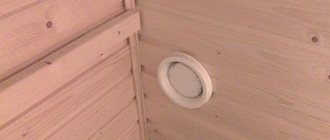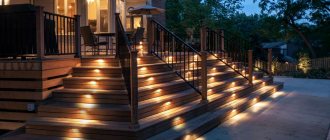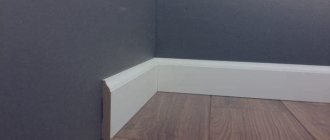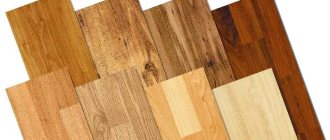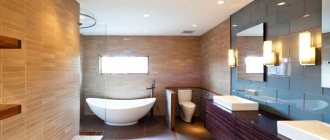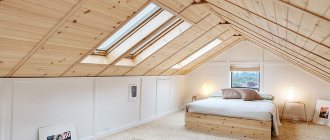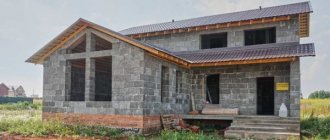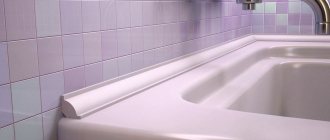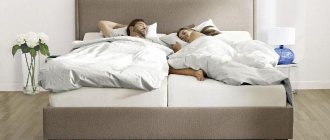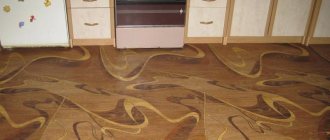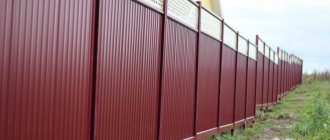The modern construction market is replete with materials for the construction of various types of fences of various configurations.
Obviously, before building fences, you should first decide on the type that is most suitable for you.
Advantages and disadvantages of different types of fences.
Despite the variety of types, there is no ideal fence: each type has its own advantages and disadvantages.
It turns out that the right choice of fence should be based mainly on your priority criteria.
The advantages and disadvantages of the most common types of fences are discussed below, and a small comparative analysis is made based on this data.
Fence based on boards.
Advantages:
1. environmentally friendly material;
2. Can be processed with both mechanical and electrical tools;
3. Installation is possible on the lightest, cheapest and simplest columnar foundation.
Flaws:
1. not fire-resistant and flammable;
2. susceptible to destruction due to wood decay, therefore requiring additional protection measures;
3. relatively short-lived;
4. is not waterproof;
5. requires a lot of manual work for additional mechanical processing, which increases construction time;
6. may not look very nice in appearance compared to other types of fences.
Wooden picket fence.
Advantages:
1. the cost is higher than that of a fence based on boards, but lower than most fences made of other materials (stone, metal, etc.);
2. aesthetic appearance;
3. ready for assembly (assembled like a children's construction set), so construction does not require much time;
4. usually built on light and cheap foundations.
Flaws:
1. like a fence made of boards, it requires protection from rotting and the action of various microorganisms, which increases the cost of construction;
2. flammable, not fire-resistant;
3. relatively short service life.
Combined fences
The construction of combined fences allows for the erection of mixed structures using different materials, for example, brick pillars and steel sheets filling the opening between them. Such a fence and fencing shows the uniqueness and personal properties of the homeowner.
Useful Advantages and types of modular fences made of corrugated sheets, mesh and wood, their characteristics
Brick and wood
A wooden fence is installed on a foundation made of concrete. Pillars made of brick are equipped with fastenings on which a canvas made of wood is installed. The boards from which the canvas is made are of different lengths and have processed edges either in the shape of a wave or in the form of corners. Self-tapping screws are used to fasten the canvas.
Brick and metal
The design of the fence often turns out to be blank; it is built when the homeowner wants to close the plot of land from prying eyes. In addition, this design reduces the noise level coming from the street and poses a serious barrier to dust.
Such fences are built both near enterprises and private buildings.
Metal and wood
Such structures are located both in new cottage villages and in summer cottages. To build these simple structures, I use metal support posts, longitudinal logs, and for filling it is permissible to use either edged boards or a ready-made picket fence, which is purchased at the nearest construction market. A distinctive feature of such structures is low cost and low labor intensity.
Metal and polycarbonate
The combination of metal and polycarbonate sections is not yet so common on land plots in our country. Meanwhile, these materials have the necessary properties in terms of strength and rigidity, and if the operating rules are followed, they will last for decades.
This fence represents the site in the style of the 21st century.
With forged elements
Some homeowners decorate fences made of brick with forged parts. Forging decorates the fence. The ratio of the filling of the fence and forged parts is determined by the designer, guided by the wishes of the homeowner.
In addition, the presence of forged parts creates additional obstacles in the path of attackers.
Fence made of corrugated sheets.
Advantages:
1. aesthetic appearance;
2. fire resistant, non-flammable;
3. may have decorative additional elements made of forged metal;
4. As a rule, does not require chemical treatment;
5. Easily subjected to mechanical and heat treatment with construction power tools;
6. wide variety of profiles;
7. due to the complex shape of the profile, it is well protected from possible deformations;
8. easy to install;
9. Construction is possible on any type of foundation.
Flaws:
1. conducts sound well;
2. in strong gusts of wind it can make a lot of noise;
3. Sheet deformations and dents are usually difficult to correct.
Main functions of fencing around the estate
In fact, the fence performs only two functions - protective and aesthetic. The first allows you to secure:
- the site and buildings - from illegal encroachments;
- plantings - from trampling and poisoning by other animals;
- owners - from unwanted attention from neighbors and passers-by, as well as from noise, dust and wind.
The second function is that the enclosing structure must fit harmoniously into the overall architecture and design style of the house, giving the site completeness.
Brick fence.
Advantages:
1. looks great in appearance;
2. durable;
3. does not require external finishing, especially when using facing bricks;
4. able to withstand high temperatures in case of fire; does not burn;
5. can show the wealth of the owner of the site by his appearance;
6. may have forged additional metal elements both for additional protection and simply for beauty.
Flaws:
1. the installation requires the construction of a heavy, expensive monolithic foundation;
2. high cost of loading and unloading operations, transportation costs, as well as the brick itself;
3. requires a large expenditure of resources (effort, money and time) for construction.
What to make a fence from: basic criteria for choosing the type of fence and material for it
For the construction of the fence the following materials are used:
- Bricks of various types;
- Tree;
- Concrete pressed panels;
- A natural stone;
- Metal;
- Plastic;
- Mesh - chain-link;
- Profiled sheeting;
- Slate.
It is also very common today to find hedges created from ornamental or wild plants and shrubs. Now we will look at the most popular and common types of fences for a summer house, private or country house.
Wooden
Wooden fences have been installed in our summer cottages and country houses for a long time. This is the most popular and affordable material for the construction of any type of fencing.
Wood is such a versatile material and easy to work with that you can install any type of fencing if desired. Wood combines well with other building materials, which is why fences made from it are in particular demand. Wooden fences can have a wide variety of variations: a blank high fence, a picket fence with certain gaps, low European-style fences, a picket fence and many others.
Advantages of wood:
- Beauty and aesthetic appearance;
- Strength and reliability;
- Ease of operation;
- Durability and reliability.
But a wooden fence needs to be looked after: treated with antifungal agents, impregnated with special anti-insect agents, and regularly varnished or painted. Thanks to modern impregnations and paints and varnishes, a wooden fence can retain its original appearance for a long time and serve for many years.
Wooden fence for a country house
Made from polyvinyl chloride
The materials that are used to make plastic fences and enclosures do not absorb or emit harmful substances into the atmosphere, so they are completely safe for people. That is why such fences can be used to create boundaries with the territory of neighboring areas. Very often, plastic fences are used on one’s own territory to create boundaries for a vegetable garden, flower beds, fencing for a house gazebo, etc.
Plastic is not susceptible to external influences such as: fungus, mold, rust, and can also withstand even large temperature changes (from -25 to +50C), so PVC fences are quite durable and can stand outdoors for 30 years or more. Currently, there are more than 30 types of plastic fences of various types and configurations.
To install the fence, only two people are required, since manufacturers offer products that are fully equipped with all the necessary elements and parts for installation within one day. Fences made of polyvinyl chloride are easy to install and just as easy to dismantle, so they can be moved from one place to another if necessary, and they will not lose their quality characteristics.
They are easy to care for, as they do not require painting, treatment with special substances or repairs. But if you suddenly accidentally damage (break) such a fence, then it will be impossible to repair it, since all sections are solid. To care for a plastic fence, you can use ordinary water and detergent.
Plastic fence for a country house
Made from pressed concrete slabs
Reinforced concrete fences are considered one of the strongest and most durable. They are usually installed on a special substrate or foundation and have many positive qualities such as:
- Resistance to mechanical damage;
- Long service life;
- Fire resistance;
- Resistance to temperature changes.
- A fence made of reinforced concrete can easily withstand even the heaviest loads, blocks street noise, and is not subject to rotting and the effects of various insects, unlike wooden structures.
Many people consider concrete to be a rather expensive material, but if you take into account its many advantages, the high price is completely justified.
Concrete fence made of reinforced slabs for a country house and cottage
Made of brick
Brick eurofences are among the most popular on the market today. And if we are talking about protecting a summer cottage or a country house, then they are simply irreplaceable. They can be divided into two types:
- The first type largely performs only an aesthetic decorative function and creates a beautiful appearance for a suburban area;
- The second type is built on a rigid foundation in compliance with all safety rules and regulations to prevent unauthorized access to the territory of the personal plot.
Brick fences are not only beautiful, but also quite durable, which is why they are very popular among many owners of country houses. They are not cheap, but their price is well justified by their long service life and beautiful appearance. Although I would like to note that brick fences, unlike concrete ones, are less resistant to strong moisture and do not withstand temperature changes well. But, meanwhile, even under the most negative operating conditions, they can easily last more than 25 - 30 years.
Brick eurofence for country houses
Polycarbonate
Modern polycarbonate fences appeared relatively recently around our sites, but they immediately gained great popularity among owners of country houses and summer cottages. Polycarbonate has a large number of advantages, including:
- Resistance to damp environments;
- Not subject to corrosion process;
- Resistant to mold, fungi and various insects;
- Not afraid of large temperature changes;
- Easily withstands heavy physical activity;
- Has a high degree of shock resistance;
- The material can take on a variety of shapes and bend in any direction.
- In addition, its cost is quite moderate, so a polycarbonate fence along with installation will cost much less than an expensive euro-fence made of brick.
Since polycarbonate has many colors, each site owner can choose the material to their liking, as well as select an individual degree of transparency. A variety of patterns and additional elements can give such a fence an original appearance.
According to its technical characteristics, polycarbonate is an impact-resistant material, but it cannot compare with natural stone, metal products and concrete. Therefore, such a fence must be treated very carefully, although it can be used for installation around the entire territory of the site.
Polycarbonate fence for suburban areas
From a variety of picket fences
Fences and fences made of picket fences can be made of metal, wood, plastic, etc. Such fences have a fairly attractive and aesthetic appearance, so they will fit perfectly into any exterior design. They can have different configurations, height levels, distances between picket fences, and any color.
Such a fence can easily be combined with any type of foundation: concrete, brick, stone, etc. Thanks to this feature, the owner of the site can bring a variety of ideas to life.
Picket fences have a long service life, and with regular maintenance this life will increase significantly. Every year it is necessary to paint the fence, carry out minor repairs if necessary and remove vegetation that is destroying the foundation. Simplicity of installation will save on the involvement of additional labor.
Euro picket fence for cottages and country houses
Metal
Metal fences are practically not deformed, are not afraid of mechanical stress (damage), and also tolerate any climatic conditions very well. That is why such fences can be installed in areas with the harshest climates.
With proper installation of a metal fence, as well as proper care for it, this design will last for many years. It is regularly necessary to carry out various preventive works: clean off any rust that has formed, treat with anti-corrosion agents and paint with special paints.
The range of metal fences is quite large: sectional, forged, solid, etc. Prices for such products depend on the quality of the material, the complexity of the work performed and its urgency. The more complex the design of a metal fence, the higher its cost will be. On the market today you can find beautiful and high-quality fencing at affordable prices. This is mainly due to the fact that numerous companies that produce metal structures simply do not have time to sell a large amount of goods during the season, and are forced to offer their products to customers at reduced prices. Typically, metal fences with a height of more than 2 meters are designed to be installed along the entire perimeter of the site, as they will best protect it from outside penetration.
Metal sectional fence for country houses
Metal welded products
Such fences are the best option for installation around any country or suburban area. Since they are made from pre-welded metal sections and are immediately treated with anti-corrosion agents, their installation takes a minimum of time. They have the same characteristics as wrought iron fencing, but are much cheaper.
Real craftsmen will be able to make a welded metal fence with almost any pattern, and if necessary, they can be combined with expensive forged parts. Also, metal sections can be installed on a stone, concrete or brick foundation in order to make the fence more stable and durable. It will look great on any area of a country house.
Metal welded fence for country houses
Fences made of profiled sheets and corrugated sheets
Fences made of profiled or corrugated sheets can fully protect a country house or country house from external penetration and the curiosity of prying eyes.
They have excellent resistance to mechanical damage (if they are not subjected to direct strong impacts), have a large selection of colors, and also have the ability to be combined with other building materials such as concrete, brick, natural stone, forging, etc.
Typically, such fences are installed on the street around the entire perimeter of the site, but if necessary, they can also be placed between neighbors.
Fence for country houses and summer cottages made of profiled sheets
Sectional metal fencing
Such fences are the most economical and simple, so they are mainly installed in dachas. They make it possible to fully provide an excellent degree of natural illumination throughout the entire territory of the site, and also limit the access of various small animals both from neighboring areas and from the street. Such fences have a high degree of strength and reliability. They are also simple and easy to care for.
Typically, sectional fences are installed by people who do not want to be completely fenced off from the outside world and prefer to see their area always open and “breathing.”
Sectional metal fencing for country houses
Decorative
Metal decorative fences are quite expensive, and they are designed to perform more of an aesthetic function than a protective one. Usually these are beautiful forged elements installed on a powerful foundation made of natural stone, brick or concrete lined with granite or marble.
There are simply a huge number of options here, and therefore every site owner can order forged fence elements with any pattern from professional craftsmen.
Decorative metal fences for country houses
Forged
The most expensive and elite forged metal fences can only be afforded by fairly wealthy people, of course, if your family does not have its own metal forging masters.
Such fences usually have original and exclusive patterns, which are made to order according to individual sketches of customers. These are durable, strong and reliable fences that can be combined with a wide variety of natural materials. Stone, concrete, and brick are suitable as a base or foundation for forged elements.
Forged metal fence for a country house
Fences made of living plants (hedges)
A natural hedge is created from various ornamental plants and shrubs, which are designed to improve the appearance of the site, as well as protect it from dust, wind and street noise.
Typically, to create such a natural fence, shrubs of hawthorn, prickly juniper, tasty barberry and other trees and plants are used. When choosing plants, it is necessary to take into account their degree of frost resistance, density, maximum height and tolerance to regular cutting.
When planting hedges, planting sites should be placed so that they are located at a distance of about 2 meters from each other. The fence can be either straight or curved, completely following the contours of the site. In order for the hedge to grow normally and develop properly, it is recommended to plant it in sunlit areas of the site. The soil must be fed and fertilized all the time, since the dense root system of shrubs very quickly depletes the soil and “sucks” all the useful microelements out of it.
But the disadvantage of such fences is that you have to wait a long time until they grow to a certain level so that they can fulfill their protective function. Also, in winter, most shrubs and trees shed their leaves, and the fence will not look entirely aesthetically pleasing.
Hedge for a country house
Metal fence:
Advantages:
1. non-flammable; fire resistant;
2. can always be decorated with decorative additional metal elements;
3. durable;
4. reliable in operation;
5. can have any pattern or shape in accordance with the tastes of the owner;
6. easy to maintain;
7. Can be built on any type of foundation.
Flaws:
1. relatively high cost of components and fence installation;
2. conducts sound well;
3. often requires additional surface treatment.
What you need to know before installing a fence
Transparent wooden fencing on the foundation
The home of a country house is fenced in accordance with the rules for placing objects. In gardening and vegetable gardening societies, the construction of opaque fences for houses between neighboring plots is prohibited. To begin with, we study the legal requirements and standards for the installation of fences. Permissible distances to buildings depend on the type and materials of the building. It is useful to find out about permits for the construction of a structure.
Before the project stage, it is necessary to draw up a diagram and coordinate it with the neighbors.
- The location of the fence on the border of the plots is clearly specified.
- An act is drawn up with a plan of the bordering areas, on which the fences are marked.
- The act specifies the installation location, height, and material of manufacture.
- After the act is signed by the neighbors, it is agreed with the cadastral engineer.
This act is reinsurance in case of litigation. If you cannot reach an agreement with your neighbors, contact surveyors. They will provide a geodetic justification and a cadastral plan of the plots so as not to go beyond the boundaries of their territory. If the site is in an urban environment, it is worth visiting the architecture department to find out possible restrictions - in case backbone networks are laid through it.
During construction, the possibility of access by a fire truck is taken into account.
Before installing a fence, pay attention to the soil and the load-bearing surface. Heavy loam or clay is prone to bulging, so you should choose a reliable installation method. This is important for the construction of heavy fences with plinths.
The choice of fence type depends on the climate and terrain. In areas of strong winds, a ventilated fence or a solid one on a reliable foundation is preferable. Windage leads to the need for frequent installation of support pillars.
Features and purpose of the design
Fence made of metal profile
The structure can be solid, ventilated, or a louvered fence:
- The blind option is safer, but it impairs visibility and obscures plants.
- The ventilated fence resembles a lattice or is assembled from modular elements. The area is ventilated and illuminated, but the area is visible from the outside.
- The shutter fence option combines the advantages of solid and ventilated structures. Inclined slats maintain ventilation and lighting of the area. The level of privacy is high. The surrounding area is visible from the inside. The reliability of iron blinds is no lower than those made of solid metal.
Purpose of installing the fence:
- property boundary designation;
- protection from animals and unwanted guests;
- saving review;
- reduction of road noise;
- reduction of wind force;
- preventing intrusion, complicating the removal of property;
- decorative fencing to emphasize the unity of style with the house;
- zoning of the internal territory;
- protection of small children and animals.
Based on the specifics of the purpose and legislative acts, the material, method of execution, height, and strength are determined. The specifics of the soil are taken into account: sometimes the fence may not be suitable for the bearing capacity of the soil.
A fence made of foam blocks.
Advantages:
1. inexpensive compared to other stone fences;
2. low cost of transportation costs;
3. the ability to build a solid fence;
4. non-flammable, able to withstand high temperatures;
5. has excellent soundproofing properties;
6. Can be easily processed with construction tools.
Flaws:
1. fence blocks are hydrophobic;
2. requires subsequent external finishing, which increases the cost of construction;
3. has low density and, accordingly, strength;
4. can only be built on strip foundations;
5. does not hold metal reinforcement well due to the low density of most brands.
Wooden fences
When deciding which fence is better and cheaper, you should not forget about wooden structures. The range of choice here is quite wide. You can use not only an ordinary inexpensive picket fence for fencing an area, but also very original wooden structures made from solid unedged boards laid on top of each other in a herringbone pattern.
Wooden fences “live” for quite a long time and this period depends entirely on the quality of processing of the material. If you do not spare antiseptics and high-quality paint, then a wooden fence will last at least 15 years. It should be noted that these fences look especially harmonious on areas with houses made of rounded logs or timber.
The latest “squeak” of the country style is a wooden picket fence made of tall posts with pointed tops. It is clear that such an unusual fence would be appropriate only for a site where all elements are consistent with the general style.
Polycarbonate fence.
Advantages:
1. does not obscure the area with its shadow due to transparency;
2. transmits light well;
3. easy and quick to assemble, but requires additional mechanical processing of the sheets;
4. can be built on the border of two adjacent plots;
5. looks impressive in appearance;
6. relatively inexpensive;
7. can be built on any type of foundation;
8. very easy to maintain.
Flaws:
1. does not have the property of fire resistance, is subject to combustion, like any organic matter with the release of harmful substances;
2. has a high coefficient of thermal expansion;
3. due to transparency, the entire site or part of it will be visible to others through such a fence.
How to choose a fence for a private house
Modern materials and construction technologies provide country property owners with the opportunity to choose the design of fencing and materials for their manufacture.
Fencing options
Homeowners are building a permanent or lightweight fence structure.
- The first objects will ensure the safety of the object; they are distinguished by a long service life, but their presence on the site leads to disruption of air movement around the site and to a decrease in the illumination of the house if it is installed in close proximity to it. Installing solid, beautiful fences for private homes will require the construction of a solid foundation and a long period of time.
- The second group is prefabricated structures. Wood, polymer materials, and metal mesh are used for construction. Such fences are cheaper, but they require constant maintenance.
- A plant fence consists of plantings of bushes, plants with large leaves, or decorative elements in the form of a fence.
Which option are you leaning towards?
To the first To the second
Degree of transparency
Modern fences and fences installed on the territory of a private house and located on the border with a neighbor’s property are assembled from mesh or lattice components. That is, they should not restrict sunlight from reaching the neighboring area. In other words, such structures are translucent.
Expert opinion
Vladimir Ulyanov
I have been involved in fences for over 10 years, answering questions and helping people cope with the installation task on their own.
Ask a question to an expert
To fence off the territory of a site from roads, forests, industrial and civil facilities, it is permissible to use a blind fence; the same fence is mounted on the side of the facade.
Height
There are some legal restrictions on the height of the fence. The permissible height does not exceed 1.5 - 2 meters. The number of floors in a building also influences the height. For structures that contain many floors, some restrictions may be revised. It is also possible to build fences with a height of 3 m or more. But the construction of fences of this type requires coordination with neighbors, even after this, the construction of a fence of this height is only permissible from the street side. Fences installed between houses cannot exceed 1-2 meters.
Useful: Choosing decorative fencing for your dacha and garden - original fences
Columnar foundation for a fence.
Advantages:
1. low cost of construction;
2. short construction time;
3. Various materials can be used as a base - wood, metal, concrete.
Flaws:
1. Cannot be installed under heavy fences;
2. not as beautiful in appearance as a monolithic fence;
3. not as reliable as a monolithic fence;
4. poles made of wood may be subject to combustion and may not be fire-resistant even after impregnation with fire retardants;
5. The service life is not as long as that of a strip fence.
Fence for a home - what materials to choose from
Now let's review the materials and try to find out their main advantages and then disadvantages.
Fence made of corrugated sheets
This material is in great demand, as it allows you to quickly build a light-tight fence for relatively little money.
Blind fence made of corrugated sheets
This material is a profiled thin sheet of iron, painted with a continuous layer of paint, and has an additional polymer coating that protects the decorative coating from moisture and ultraviolet radiation.
Metal prices depend on the manufacturer and type of corrugation. It is impossible to even display the average price - you can check this yourself by going to the websites of the selling companies.
Which profiled sheet to choose for a fence at the dacha: profile S-8 is an excellent material for cladding a fence
This price range is influenced by the following components:
- Metal thickness.
- Profile height.
- Quality of polymer coating.
Each factor affects the strength of the sheet. An important parameter is the profile height. It is measured in millimeters and means the difference in the ridges. The higher it is, the more metal is used per sheet, which means the price will be higher. The optimal profile for a fence is 8 mm in height. Those that are larger can also be used, but they are often used for the roof.
When purchasing profiled sheets, inquire about the warranty on the decorative coating. Cheap sheets will begin to fade in the sun after 5-6 years. There are also those that only have a 10-year warranty, and the difference in price will not be very large.
The good thing about fences made from corrugated sheets is that they are easy to install yourself. The work will require welding skills.
Installation of a fence at the dacha made of profiled sheets
Disadvantages of a fence made of corrugated sheets:
- Since such a fence is budget-friendly, they save on everything - the posts are placed in increments of 2.5-3 meters, and 2 cores are used. Because of this, the fence is quite easy to bend. The wind, of course, won’t tear it off, but you can push it through with your hands.
- When doing self-cladding, people do not use a riveter, which is why the metal joints remain visible to the eye, which greatly spoils the entire design.
- When the coating begins to fade, the fence is repainted. As you understand, its appearance will not be the same as after installation - it will be covered in dust, or streaks of paint will remain visible.
- The metal becomes very hot in the sun, which is why flowers grow poorly along such a fence and suffer from elevated temperatures. Take this point into account when planning your site and make plantings where there is no direct sunlight on the fence for a long time.
Block or monolithic foundation for the fence.
Advantages:
1. beautiful appearance;
2. evenly distributes and transfers the load of spans and fence posts to the ground;
3. Can be used with both light and heavy fences;
4. partially performs a protective function;
5. resistant to high temperatures, not subject to combustion;
6. good sound insulator.
Flaws:
1. large expenditures of effort and time for construction;
2. high cost of construction.
In general, the foundation strip is built for heavy fences, as well as to obtain a beautiful design for both the fence and the entire site.
It can also indicate the wealth of its owner.
However, such a foundation will not be cheap.
Basic criteria for the right choice.
Let us list the criteria on the basis of which a decision on the type of future fence should be made and analyze them:
the amount of financial effort, money and time that you are able to devote to building a fence.
If you don’t have a lot of money, then it’s better to immediately pay attention to inexpensive fences based on a columnar foundation: chain-link fences, polycarbonate, slate, wood and corrugated sheets.
If you have the opportunity to do everything yourself (you have enough strength, experience and time), then you can save money by building a fence with your own hands from slate, boards or polycarbonate.
Otherwise, you will have to buy ready-to-assemble building materials - picket fences, corrugated sheets.
It is more expensive, but you will save time and effort: the assembly of such fences is very easy and fast, even for a person without experience in construction.
If you have sufficient funds, then it would be better to immediately opt for a strip foundation.
It is largely universal.
the main purpose of the building.
If the main function of the future fence is to protect against unauthorized entry into the site, then you should immediately build a high, solid fence based on heavy base materials.
The most suitable here may be stone (gas-concrete, foam concrete), brick fences and fences based on corrugated sheets.
The last option is the cheapest and much faster to assemble and install, but the least durable, not as reliable as fences made of stone and brick.
If the function of simply marking boundaries is pursued, then you can get by with cheap fences: wooden picket fences, boards, slate, chain-link mesh, etc.
If the decorative function is a priority, then different options are possible.
First, you can choose an inexpensive fence, and then decorate it with wrought iron, vegetation, or use a spectacular, beautiful finish.
Another way is also possible - selecting a fence for other already built objects on the site.
durability and the requirements that the fence makes for its maintenance.
Stone and brick fences can be considered the most durable and reliable, but they are also the most expensive.
The least durable fences, the most demanding in terms of maintenance and care, but also the cheapest are fences made of boards, wooden picket fences, and slate.
Often, durability depends not so much on the material of the fence itself, but on its proper use by the owner himself.
fit into the overall design of the site, its harmony with other buildings.
The most beautiful fences are fences on a strip foundation.
This includes all types of fences that are ready for sale in stores and that are quickly assembled on the site like a construction set.
On the other hand, a regular fence can be supplemented with decorative additional elements after the construction stage.
It looks good to select a fence material that matches the material from which an object has already been built on the site.
For example, it would be quite logical to build a brick fence under a brick house.
In small areas, blind high fences are unlikely to be appropriate due to the strong shading of the area from them, but it is quite possible to use a chain-link mesh, picket fence, polycarbonate, metal gratings, etc.
Even the simplest type of fence will fit well into the design of the site if it is decorated with beautiful vegetation.
For example, a chain-link mesh is often combined with climbing plants planted near it.
The fence looks like it’s alive and natural.
Official rules for the construction of fences in the private sector
Fences of suburban areas are erected taking into account the provisions of SNiP No. 30−02−97. The main principle enshrined in SNiP is that the fence should not interfere with normal street lighting and shade neighboring areas. In particular, this document includes recommendations regarding:
- Heights. On the side of the street or roadway, the fence should be no more than 2.5 meters, between neighboring areas - up to 1.5 m. In this case, neighbors can agree to install a higher fence at the boundary. This agreement must be enshrined in writing to protect yourself from claims and disputes in the future.
- Transparency. On the outside of the site, the fence can be solid, regardless of height. Between neighboring plots you can build a continuous fence up to 0.75 m high. If you want to make it higher, you need to use structures with transparency of more than 50% (mesh, lattice elements, etc.). As in the first case, neighbors can draw up a written agreement to install a blind fence of the required height at the boundary.
- Distances The fence should be 5 meters away from the road, 3 m from the driveway. The distance between the fence and the house should also be at least 3 m.
Based on the provisions of SNiP, the administration of a locality can adopt its own rules that will need to be taken into account.

